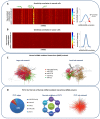Network-Based Approaches to Explore Complex Biological Systems towards Network Medicine
- PMID: 30200360
- PMCID: PMC6162385
- DOI: 10.3390/genes9090437
Network-Based Approaches to Explore Complex Biological Systems towards Network Medicine
Abstract
Network medicine relies on different types of networks: from the molecular level of protein⁻protein interactions to gene regulatory network and correlation studies of gene expression. Among network approaches based on the analysis of the topological properties of protein⁻protein interaction (PPI) networks, we discuss the widespread DIAMOnD (disease module detection) algorithm. Starting from the assumption that PPI networks can be viewed as maps where diseases can be identified with localized perturbation within a specific neighborhood (i.e., disease modules), DIAMOnD performs a systematic analysis of the human PPI network to uncover new disease-associated genes by exploiting the connectivity significance instead of connection density. The past few years have witnessed the increasing interest in understanding the molecular mechanism of post-transcriptional regulation with a special emphasis on non-coding RNAs since they are emerging as key regulators of many cellular processes in both physiological and pathological states. Recent findings show that coding genes are not the only targets that microRNAs interact with. In fact, there is a pool of different RNAs-including long non-coding RNAs (lncRNAs) -competing with each other to attract microRNAs for interactions, thus acting as competing endogenous RNAs (ceRNAs). The framework of regulatory networks provides a powerful tool to gather new insights into ceRNA regulatory mechanisms. Here, we describe a data-driven model recently developed to explore the lncRNA-associated ceRNA activity in breast invasive carcinoma. On the other hand, a very promising example of the co-expression network is the one implemented by the software SWIM (switch miner), which combines topological properties of correlation networks with gene expression data in order to identify a small pool of genes-called switch genes-critically associated with drastic changes in cell phenotype. Here, we describe SWIM tool along with its applications to cancer research and compare its predictions with DIAMOnD disease genes.
Keywords: PPI network; bioinformatics; ceRNA; gene co-expression network; network medicine; regulatory network.
Conflict of interest statement
The authors declare no conflict of interest.
Figures












Similar articles
-
Construction and analysis of dysregulated lncRNA-associated ceRNA network identified novel lncRNA biomarkers for early diagnosis of human pancreatic cancer.Oncotarget. 2016 Aug 30;7(35):56383-56394. doi: 10.18632/oncotarget.10891. Oncotarget. 2016. PMID: 27487139 Free PMC article.
-
Comprehensive characterization of lncRNA-mRNA related ceRNA network across 12 major cancers.Oncotarget. 2016 Sep 27;7(39):64148-64167. doi: 10.18632/oncotarget.11637. Oncotarget. 2016. PMID: 27580177 Free PMC article.
-
Construction and analysis for differentially expressed long non-coding RNAs and MicroRNAs mediated competing endogenous RNA network in colon cancer.PLoS One. 2018 Feb 8;13(2):e0192494. doi: 10.1371/journal.pone.0192494. eCollection 2018. PLoS One. 2018. PMID: 29420609 Free PMC article.
-
Computational methods for identifying miRNA sponge interactions.Brief Bioinform. 2017 Jul 1;18(4):577-590. doi: 10.1093/bib/bbw042. Brief Bioinform. 2017. PMID: 27273287 Review.
-
Competing endogenous RNA interplay in cancer: mechanism, methodology, and perspectives.Tumour Biol. 2015 Feb;36(2):479-88. doi: 10.1007/s13277-015-3093-z. Epub 2015 Jan 22. Tumour Biol. 2015. PMID: 25604144 Review.
Cited by
-
Identification of lncRNAs associated with lung squamous cell carcinoma prognosis in the competitive endogenous RNA network.PeerJ. 2019 Sep 17;7:e7727. doi: 10.7717/peerj.7727. eCollection 2019. PeerJ. 2019. PMID: 31576252 Free PMC article.
-
Next Generation Networks: Featuring the Potential Role of Emerging Applications in Translational Oncology.J Clin Med. 2019 May 11;8(5):664. doi: 10.3390/jcm8050664. J Clin Med. 2019. PMID: 31083565 Free PMC article.
-
In silico drug repurposing in COVID-19: A network-based analysis.Biomed Pharmacother. 2021 Oct;142:111954. doi: 10.1016/j.biopha.2021.111954. Epub 2021 Jul 28. Biomed Pharmacother. 2021. PMID: 34358753 Free PMC article.
-
LncRNA LINC00313 Knockdown Inhibits Tumorigenesis and Metastasis in Human Osteosarcoma by Upregulating FOSL2 through Sponging miR-342-3p.Yonsei Med J. 2020 May;61(5):359-370. doi: 10.3349/ymj.2020.61.5.359. Yonsei Med J. 2020. PMID: 32390359 Free PMC article.
-
Competing Endogenous RNAs, Non-Coding RNAs and Diseases: An Intertwined Story.Cells. 2020 Jun 28;9(7):1574. doi: 10.3390/cells9071574. Cells. 2020. PMID: 32605220 Free PMC article. Review.
References
Publication types
LinkOut - more resources
Full Text Sources
Other Literature Sources
Miscellaneous

